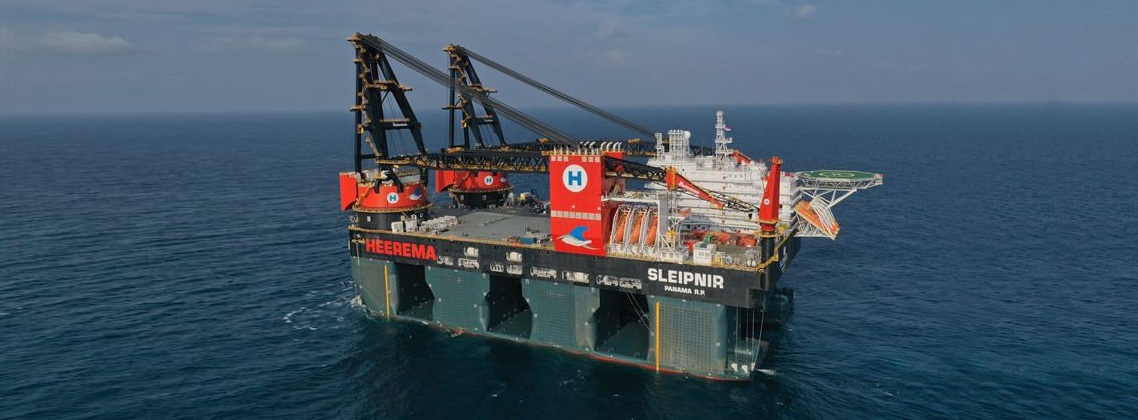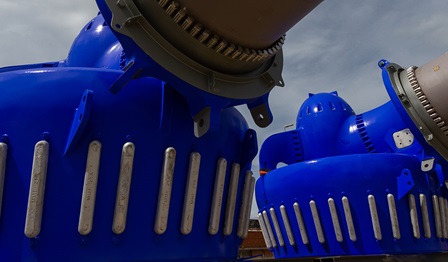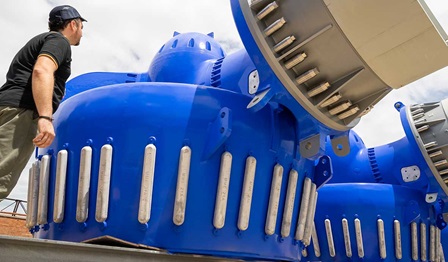

Wärtsilä Underwater - Mountable Thrusters
Reliability and performance
The Wärtsilä underwater mountable thruster are designed for safe and reliable operation under demanding conditions. The proven underwater mounting method enable maintenance to the thrusters with the vessel afloat, taking out the need for dry-docking of the vessel.
The underwater mountable thruster features an optimised design and the Wärtsilä Thruster Nozzle to provide excellent bollard pull performance. By the 8° tilted propeller gearbox the thruster-hull interaction losses are significantly reduced. The benefits of the underwater mountable thrusters enable superior and reliable DP performance.

Key benefits
- Exchangeable underwater for vessels that do not have access to dry docking facilities
- Underwater mounting with diver support, optionally ROV operated mounting method
- High bollard thrust and propulsion efficiency
- Effective DP operations thanks to the 8° tilted propeller shaft or 3° tilted nozzle
- Electric L-drive up to 6500 kW
- First class reliability
- Wide power range
- Compact and light design
- Easy installation
- Optional compliance with CLEAN notations and US EPA VGP2013 requirements
Application
- The Wärtsilä Underwater Mountable Thruster series can offer a tailor-made solution to meet customer requirements, for example: bollard pull, vessel speed or vessel propeller size limitations.
- The underwater mountable series has a high maximum power output of up to 6500 kW.
- The underwater mounting and the high performance make the thruster favourable for use on large offshore construction vessels (OCV), semi-submersible drilling rigs, drillships, semi-submersible accommodation rigs, crane vessels, pipe layers and other vessels requiring thrusters that can be mounted while the vessel is afloat.
Technical Info
Main technical data
| Thruster type | Power (1) [kW] |
Input speed [rpm] |
Propeller diameter (A) [mm] |
Tilt | |
|---|---|---|---|---|---|
| WST-45U | 4000 4500 |
720 600 |
3600 | 8° | |
| WST-55U | 4500 5500 |
720 600 |
3900 | 8° | |
| WST-65U | 5500 6500 |
720 600 |
4200 | 8° | |
Dimensions and weights
| Thruster type | A | B | C | M | L | H | Outboard part1 |
Well2 | ||
|---|---|---|---|---|---|---|---|---|---|---|
| dry | in water | |||||||||
| WST-45U | 3600 | 3300 | 2518 | 2324 | 2570 | 1241 | 51000 | 34500 | 9500 | |
| WST-55U | 3900 | 3625 | 2648 | 2516 | 2763 | 1390 | 63500 | 41800 | 11900 | |
| WST-65U | 4200 | 3820 | 3006 | 2719 | 3025 | 1390 | 77500 | 49500 | 13200 | |
2 - Including top, bottom, and pipe covers plus valves and position sensor
Power ranges


WST-RU
The Wärtsilä Retractable Underwater Mountable Thruster (WST-65RU) has been designed to meet the needs of large offshore construction vessels (OCVs) as well as semi-submersible rigs and drill ships.
With its power output up to 6500kW it is typically designed for vessels that require thrusters that can be retracted during transit of while entering shallow waters, to increase the level of operational flexibility. Additionally, the WST-65RU thruster can be mounted or de-mounted while the vessel is afloat, to facilitate thruster maintenance and overhaul during the operational lifecycle meaning there is no requirement for drydocking. The WST-65RU is the first retractable thruster in the market to feature the unique combination of retractable and underwater mountable functionality.
The WST-65RU is based on the WST-65U underwater mountable thruster which has been designed with performance and reliability as key requirements. The 8° tilted propeller shaft solution is a feature which is also found on Wärtsilä Underwater Mountable thrusters and reduces the interaction between the thrusters and hull significantly, thereby enhancing the dynamic positioning performance of the vessel. The outboard part of WST-65RU is exchangeable with WST-65U, optimizing maintenance and spare part strategies.
In combination with Wärtsilä’s PCMS (Propulsion Condition Monitoring Service) downtime and maintenance costs can be minimized.
Key benefits:
- Optimised thrust enabling effective DP operations
- Retractable
- Thruster outboard part can be exchanged without dry docking the vessel
- A telescopic shaft allows a static mounting of the E-motor and ease
- Integrated solution provides smallest possible area footprint and overall lighter construction
- Based on proved recognizable technology and in-house propeller design know-how

Product hologram
Why choose Wärtsilä
Each component and aspect of the underwater mountable thruster series has been selected to achieve a high level of reliability. With the Wärtsilä PCMS (Propulsion Condition Monitoring Service), the reliability and availability of the thruster can be improved even further. As this service is recognized by the main marine class societies, the thruster overhaul intervals can be extended according to the condition of the equipment
The Wärtsilä Underwater Mountable Thruster series feature an 8 degree tilted propeller shaft and nozzle, which direct the propeller jet away from the hull and other thrusters. In addition to reducing hull interaction losses, this also greatly reduces interaction between the thrusters, thus making the so-called ‘forbidden zones’ considerably smaller. The unique design means that customers can expect up to 20% more effective thrust than conventional non-tilted thrusters, depending on vessel configuration and application.
The excellent efficiency and performance of Wärtsilä Underwater Mountable Thruster are further enhanced by the capability to design and configure the optimal configuration and power requirements to fit the vessel actual operating profile and needs of the owner. This is achieved through the use of advanced calculations including hydrodynamics and computational fluid dynamics (CFD) and includes the ability to add system failures to ensure safe operation. The result of these calculations and analysis allow for an accurate view of the thruster position, combination of thruster type, and most importantly the power required to deliver the thrust to support vessel operations safely and efficiently – this detailed insight allows the correct total vessel power requirement to be calculated rather than estimated, which can reduce the cost of the total power train configuration.
By bringing together these technologies and expertise in a single configurable solution approach, the optimal solution can be agreed, which when combined with Wartsila’s thruster performance results in reduced overall weight and increased performance. This ensures that owners, operators and yards benefit from significant savings and efficiencies not before possible.



Effective DP operations
The three largest thrusters within the Wärtsilä Underwater Mountable Thruster series feature an 8 degree tilted propeller shaft and nozzle, which direct the propeller jet away from the hull and other thrusters. In addition to reducing hull interaction losses, this also greatly reduces interaction between the thrusters, thus making the so-called ‘forbidden zones’ considerably smaller. The overall gain in effective bollard pull thrust for dynamic positioning operations is about 15% when compared to conventional units.
High efficiency
The Wärtsilä Underwater Mountable Thruster series features the Wärtsilä thruster nozzle to provide excellent bollard pull performance.
First class reliability
Each component and aspect of the underwater mountable thruster series has been selected to achieve a high level of reliability. With the Wärtsilä PCMS (Propulsion Condition Monitoring Service), the reliability and availability of the thruster can be improved even further. As this service is recognized by the main marine class societies, the thruster overhaul intervals can be extended according to the condition of the equipment.
Compact and with less weight
Detailed FEM analyses have been made to optimize the strength of the components so as to keep the overall weight as low as possible. Compact dimensions result in less space requirements in the thruster room and more payload capacity for the vessel.





